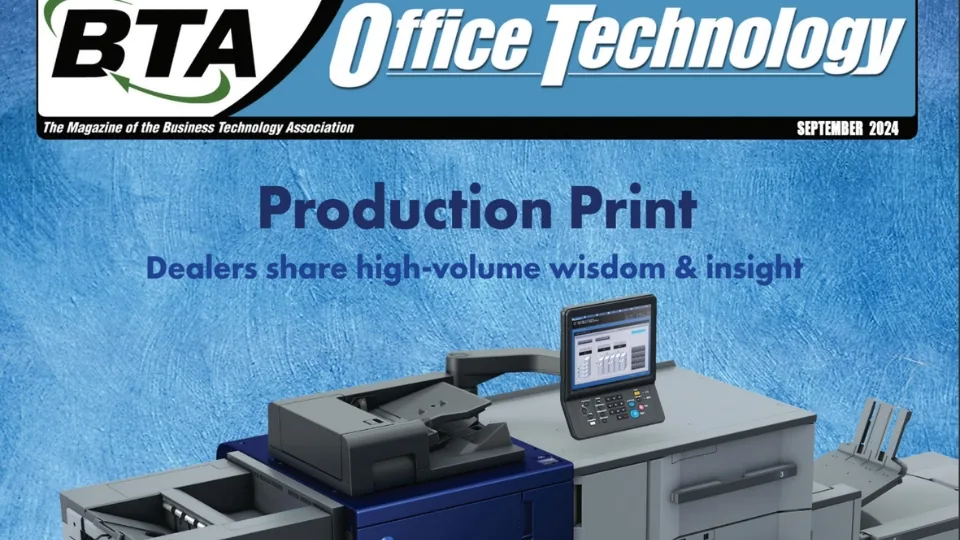Multiply Time, Multiply Output: Why BTA Featured Smart Technologies’ CEO on Production Print
Smart Technologies of Florida has been talking about time and throughput for years, but the conversation reached a wider audience recently when CEO Bob Doucette was featured by the Business Technology Association (BTA) in an article on production print, where dealers shared their high-volume wisdom and real-world insights. The recognition matters for two reasons. First, BTA showcases voices that move the industry forward, so the feature serves as an external signal that the practices we champion deliver measurable value. Second, it connects the dots between Bob’s larger message—how leaders become multipliers of time—and the most demanding corner of print, where tight schedules and exacting quality are everyday reality.
This blog keeps the spotlight squarely on that feature and the topic at hand. It spells out how Bob’s approach translates directly into production environments, why dealers across the country resonated with it, and what a shop can accomplish when it treats time like capital and workflow as a compounding asset.

Why the BTA Feature Matters
BTA does not publish theory for theory’s sake. Its readers run dealerships, service teams, and production floors that must perform under pressure. When Bob was invited to contribute to BTA’s discussion on production print, the editorial goal was clear: distill the kind of street-level wisdom that separates shops that fight fires from shops that hit deadlines without drama. Being featured in that context underscores a simple point—our approach is not a slide deck. It is a set of habits any dealer can adopt, and when they do, the numbers move.
Bob’s perspective anchored the conversation around a principle he champions often: Return on Time. Everyone gets the same 168 hours each week. A production operation cannot manufacture hours out of thin air, but it can invest time in targeted improvements that pay back every shift. The BTA editors were interested in how this mindset plays out where it counts most: the intake desk, the RIP, the press, and the finishing line. Bob’s contribution explained that, in a high-volume setting, a single improvement—made once and documented well—can repay itself hundreds of times, long after the pilot glow fades. That is why the feature led with dealer experience rather than gadget talk. The most important upgrades are often cultural and procedural before they are technical.
A Feature About Production Print That Starts With People
Bob’s BTA piece positioned production print as a human system first. Gear matters, but people turn gear into profit. In shops that run smoothly, operators trust their presets, count on their media paths, and begin their day with color that lands where it should. Customer service representatives know exactly how finished files should arrive, which means fewer back-and-forth emails and fewer last-minute rescues. Managers protect the hours when big runs must flow, which is why problems stay small and schedules feel generous even when orders spike. None of this happens by accident. It grows out of a way of working that asks the same questions again and again: does this step deserve to exist, can a machine do it, who else can own it, can it wait without risk, and if it must be done now, how do we protect the focus to finish it?
Dealers featured alongside Bob emphasized that the shops who win rarely advertise their advantage. They are not the loudest about theoretical print speeds. They are the quiet ones with a reputation for not missing. BTA highlighted this not to romanticize calm, but to show that calm is a byproduct of design. Bob’s framing resonated because it gave readers a vocabulary to discuss the choices that make calm possible.
From ROT to Real Throughput
Readers of Office Technology Magazine might have encountered Bob’s separate essay on “unlocking time with AI.” The BTA feature made an explicit bridge from that idea to the press room. In the magazine piece, Bob argued that many office tasks can be redesigned to remove repetition. In production print, the same principle eliminates touches between systems. Shops invest a focused burst of energy to set up hot folders that preflight and impose the top five job types the same way, every time. They commit a deep-work block to profiling a handful of tricky stocks and documenting a morning routine for color that takes minutes rather than guesswork. They standardize file naming so jobs route correctly without interpretation. They organize finishing pathways so crease, fold, stitch, and trim happen in sequence without dead zones. Each investment is small. Together, they turn hours of friction into a steady breeze.
This is the heartbeat of the BTA feature. Bob did not argue for an abstract transformation. He described a dozen specific places where a one-time change returns time all year. Dealers validated the approach with their own stories: fewer remakes because color holds; fewer jams because stock profiles are dialed in; fewer emails because intake expectations are clear; fewer surprises because the finishing layout matches the jobs customers actually buy. The story is not glamorous, and that is the point. Glamour does not pay the lease. Predictability does.
What High-Volume Wisdom Sounds Like
The phrase “high-volume wisdom” appeared throughout BTA’s coverage for good reason. At scale, the truth shows up in patterns. One pattern Bob highlighted is the difference between speed and uptime. A device’s rated pages per minute can lure teams into false confidence. What pays the bills is the percentage of a day the device actually produces sellable pages without interruption. Uptime grows when maintenance is routine, consumables are predictable, and operators are trained to spot issues before they cascade. It grows when you reduce the number of handoffs between systems and people. It grows when finishing is planned as part of the job rather than treated as an afterthought. These are not controversial ideas, but they are easy to forget when a deadline approaches. BTA featured the dealers who remember them daily and build muscle memory around them.
Another pattern is the outsized cost of remakes. Reprints do not merely waste paper. They consume operator time, crowd schedules, and erode confidence. Bob’s advice, which the BTA editors spotlighted, is to treat repeatable color as a profit center. A small investment in spectrophotometry, stable profiles, and habit-forming routines repays itself through fewer make-goods and fewer calls from customers asking why a brand red suddenly looks tired. When color stays true, trust compounds. That trust becomes the reason a customer chooses you for a job that cannot slip.
A third pattern is the power of operator enablement. Many shops upgrade a device but underinvest in the people who will pull the most value from it. Bob urged readers to think of enablement as the best upgrade you can buy. When operators have a clear playbook, a path to mastery, and confidence that problems have known remedies, morale rises and schedules smooth out. It is not romantic to say that skilled operators are the backbone of production print; it is accurate. BTA featured this because dealers who neglect enablement inevitably reach for another device to solve a problem that is, at its root, a process and training issue.
The Feature and the Field Guide
Because Bob’s BTA feature sat among contributions from other dealers, it functioned as both validation and a field guide. Validation came from the shared emphasis on habit over hype. The field guide came from the way these habits sequence. Shops do well when they first remove steps that do not create value. They then automate the steps that must be done but do not require human judgment. They delegate ownership so that responsibility sits with the person closest to the work. They consciously delay experiments that might derail an afternoon of guaranteed production. And when the moment arrives to run, they protect the time and attention required to run without interruption.
Readers who followed the feature found that this sequence maps neatly to their daily frustrations. A customer sends a file at 3 p.m. that fails preflight, and the team wastes half an hour diagnosing a problem that a hot folder could have caught before anyone touched it. A stock change adds minutes to setup because the path and profile are not saved and tested. A booklet run stalls because the finishing station is arranged for yesterday’s job mix. These are not moral failings. They are invitations to invest once and collect the dividends every day after. The feature made this tangible, which is why it has been circulating in dealer Slack channels and shop floor break rooms.
How Smart Technologies Puts the Feature to Work
A feature is flattering; results are better. At Smart Technologies, we have turned Bob’s BTA message into a straightforward engagement sequence. We sit with a customer and walk one live job from intake to invoice. We ask hard questions about which steps deserve to exist. We set up one or two automations that remove repetitive decisions. We train operators on one routine that builds confidence at the start of the day. Then we measure what changed: fewer touches, fewer emails, fewer remakes, more on-time deliveries. The numbers almost always shift within weeks because the improvements are small, surgical, and close to the work.
When a customer is ready, we bring AI to the supporting tasks. Quoting, proofing notes, internal updates, and end-of-day summaries are ripe for assistance. The goal is not to replace judgment. The goal is to compress the overhead around judgment so that people spend more of their day doing the part that matters. In production print, the press keeps moving; in the office, communication stays clear without devouring the clock. The shared thread is respect for time as the scarce resource that multiplies when treated well.
A Note on Culture that BTA Understood
Readers often ask how to keep momentum once the first round of improvements lands. Bob’s answer, echoed in the feature, is to treat the workflow as a living product. Celebrate small wins so teams internalize that improvements are part of the job, not one-off events. Write short playbooks so knowledge survives turnover and vacations. Protect deep-work blocks for the people who own color, media, and finishing presets. Invite operators to propose the next improvement, and make it easy to test during low-risk windows. When a culture sees itself as a builder of systems rather than a survivor of chaos, the compounding begins.
BTA chose to highlight leaders who build such cultures because the industry needs more of them. As run lengths shrink and expectations rise, the only sustainable edge is a shop that learns. The Smart Technologies message—that time can be invested and workflow can be designed—gives that learning a shape and a cadence.
Bringing It Back to the Feature
Let’s keep the spotlight where the headline promised. Bob Doucette’s BTA feature on production print recognized the work Smart Technologies has done to help dealers and in-plant teams turn complicated production environments into reliable engines. The article focused on dealer-tested wisdom rather than buzzwords. It showed how Return on Time becomes return on throughput when you remove unnecessary steps, automate the repetitive ones, enable operators to own their craft, and place finishing on equal footing with print. It underscored that uptime outperforms nameplate speed, that color consistency protects margins, and that calm schedules are earned by design, not chance.
The feature also marked a bridge between conversations. Many readers had already seen Bob’s views on multiplying time in Office Technology Magazine. BTA took those views to the floor where ink meets substrate and where deadlines decide reputations. If you read both pieces together, a simple philosophy emerges: do the work once so the work pays you back, hour after hour and job after job. In leadership meetings, that means automating administrative drag and protecting focus. On the press, that means a workflow that moves without friction and a team that trusts the system.
What You Can Do Next
If you are a dealer principal, a production manager, or a leader with a shop that feels one change away from breathing easier, the path forward is not mysterious. Start by naming one product line that occupies a big share of your month. Map the path that product takes from the customer’s first message to the moment a box leaves your dock. Ask which steps do not create value and remove them. Choose one place to automate a decision you make repeatedly. Give your operators a crisp routine that guarantees color and media sanity every morning. Track results for thirty days. Then repeat.
If you would like a partner who has walked this path many times, we would be honored to help. The approach BTA featured is the one we practice. It is practical, measurable, and respectful of the people who make the work happen. Most of all, it is aligned with the topic that brought you here: raising throughput in production print without raising blood pressure, by investing time once and letting the system repay you for years.
Congratulations to Bob Doucette on his BTA feature highlighting production print and the dealer insights that keep this industry moving. If you want to see how those ideas translate inside your operation, connect with Smart Technologies of Florida. Let’s build a workflow that multiplies your time and your output—so your next deadline feels like a promise kept, not a race survived.












